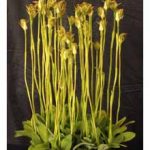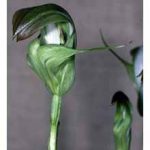Commonly known as greenhoods, rusty hoods or maroon hoods, members of the genus Pterostylis seem to be the unlikeliest flowers to be called orchids, but orchids they are. There are more than 120 species in Australia, more than 60 of them in Victoria and 37 in Tasmania, although many are common to both states. A peculiar characteristic of Pterostylis is the fused lateral sepals that rise from the base of the flower before separating to form two tails above a dorsal sepal. Together they form a hood (botanically known as a galea) above the column and lateral sepals.
Depending upon the species, the genus Pterostylis can be found in nature from sea level to alpine areas and in all types of terrain and climates. Most species have only one flower per stem but some multi-flowered species have as many as 24. Although they are commonly known as greenhoods, the colour of the flowers may range from green to brown, some species having reddish brown or maroon flowers. Green is by far the most common colour, although it may vary from light to dark green, often with white or translucent stripes. Flower size may vary from quite small {e.g. P. parviflora) to relatively large {e.g. P. baptistii). All are terrestrial orchids that become deciduous each year, usually in summer.
Growing pterostylis species or hybrids is so easy that many growers don’t consider it to be sufficiently challenging. However, there are so many greenhoods that one could make an extensive collection of this genus alone. Many books and orchid society bulletins provide recipes for special terrestrial orchid potting mixes but some growers have excellent results using general potting mixes from their local nursery. Greenhoods are unsuitable for indoor culture but grow happily outdoors under shade cloth, preferably with a wire netting cover to keep blackbirds from digging out the plants in their search for worms.
Greenhoods commence growth from a subterranean tuber, usually in late winter, in many cases producing a rosette of leaves from which the flower stem emerges. In some cases the flower stem emerges beside the leaf rosette, while in a few cases the rosette withers before the flower buds open. All species may be propagated from seed but many also develop extra tubers, and thus form large colonies. If undisturbed, ten or a dozen tubers in a six-inch pot may multiply to a crowded potful within a few years.
When grown outdoors the plants need little more water than provided by general rainfall, except in periods of drought. The plants should be kept quite dry during the dormant period. Fertiliser should be used sparingly and only when the leaf rosettes are developing.
The easiest species for the beginner to grow are Pterostylis curta, P. nana and P. pedunculata, while the most attractive, easily grown hybrids are P. Cutie, P. Ingens and P. Jack Warcup.

